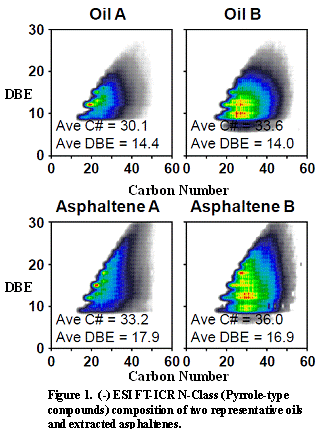57th Annual Report on Research 2012 Under Sponsorship of the ACS Petroleum Research Fund
Reports: UR650670-UR6: Petroleomics: Elucidation of Chemical Composition and Functionality of Compounds Resistant to Asphaltene Inhibitors
Geoffrey C. Klein, PhD, Christopher Newport University
Introduction
This ACS-PRF grant supports laboratory work on the characterization of crude oils and their asphaltene fractions for the determination of those compounds resistant to asphaltenes inhibitors. The three specific aims of this study are to fully characterize (elemental formulae and functional group composition) the asphaltenes fraction of a number of different crude oils, determine the effect amphiphiles have on the inhibition of asphaltenes precipitation and use model compound fragmentation studies to investigate functional group composition. A new titration experiment will be employed to gain detailed knowledge of the flocculation process of asphaltenes both in the presence and absence of inhibitors. The use of mass spectrometric techniques and Infrared spectroscopy will provide detailed elemental and functional group composition for the comparison of the asphaltenes compounds throughout the titration experiment.
Research Progress
We have engaged in two of the three specific aims of this study during the first year (1/1/2011-8/31/2012) reporting period. The first year of the grant period was focused on the bulk characterization of the oils under investigation, the collection of the asphaltene fractions and the analysis of model asphaltenes-like compounds by low resolution electrospray ionization mass spectrometry (ESI-MS).
Aim 1 - Fully characterize (elemental formulae and functional group composition) the asphaltene fraction of a number of different crude oils by titration experiments, mass spectrometry (FT-ICR MS) and Attenuated Total Reflectance FT-IR (ATR FT-IR).
In response to reviewer comments, an additional oil was added to the study. Four separate oils will now be analyzed as part of this study. The four oils include two heavy oils, one medium and a light oil. Asphaltenes were extracted from all four bulk oils following a modified ASTM 2007 method. This method involved the addition of hexane, followed by filtering. A grant seeking instrument time at the National High Magnetic Laboratory was written and submitted for the analysis of the bulk oils and their asphaltenes. After instrument time was awarded, all eight samples were analyzed by a homebuilt 9.4 T Electrospray Ionization Fourier Transform Ion Cyclotron Mass Spectrometer. The ultra-high resolving power and high mass accuracy afforded the elemental analysis of all eight samples. All eight samples were analyzed in positive and negative mode for the investigation of the basic and acidic components, respectively. The bulk oils had ~6000 – 11000 chemically distinct peaks, while the asphaltenes ranged from ~4000 – 25000 peaks. Unfortunately, elemental formulae assignment and class (Double bond equivalence and Carbon number information) provide little differentiation between the bulk oils and asphaltenes, see Figure 1 for an example of bulk oil and asphaltene comparison of acidic, polar constituents in two oils (light oil, A and heavy oil, B). There is very little difference in the DBE (number of rings plus double bonds) and carbon number distribution in this N-class, pyrrole-like compounds. After examination of the asphaltene extraction process, it was determined that the extraction process not only collects asphaltenes, but also maltenes. A new extraction technique (IP-143) has been investigated and is currently being employed in the research lab. This technique utilizes the precipitation of asphaltenes with n-heptane followed by a washing step to remove any maltenes that co-precipitated. After the washing step, the asphaltenes are then collected by soxhlet extraction with toluene. They are then dried and weighed for calculation of the percent composition. An organic analyzer will be employed to confirm the collected of asphaltenes based on the H:C ratio prior to analysis by ESI FT-ICR MS.
The titration experiment has been employed on the asphaltenes collected by the ASTM 2007 method utilizing spectrophotometry as a means to semi-quantitate the flocculation process as the solvent environment becomes more non-polar (addition of n-heptane). This method will be employed when asphaltenes collected by the IP-143 method has been complete. Detailed composition of fractionated asphaltenes will provide one of the first studies of asphaltene flocculation from solvent environment changes.
 |
Aim 3 - Use of model compound fragmentation studies for the determination of the functional group composition of asphaltene species by FT-ICR MS and ATR FT-IR.
Fragmentation studies have been performed on a number of asphaltene-like compounds to determine fragmentation patterns for a number of different functional groups. The fragmentation studies were performed on a low-resolution ESI-MS (ThermoFisher LCQ-Fleet). We have found unique fragmentation patterns for compounds such as those that contain a carboxylic-acid group. Work will continue on the low resolution instrument to develop a fragmentation library before structural information is attempted to be analyzed via ESI FT-ICR MS.
Conclusion
Work remains on target despite asphaltene extraction setback. The NHMFL instrument grant will provide opportunities for undergraduate students to access the highly advanced ESI FT-ICR mass spectrometric technique. The PRF grant has provided summer support for three undergraduate students. During the grant reporting period, six presentations at regional and national conferences were given by either the principle investigator or undergraduate students. Rebecca Beasley (now at Florida State University for graduate school) won an Undergraduate Research Award to present her work on the mass spectrometric analysis of crude oils at the 2011 Eastern Analytical Symposium.










